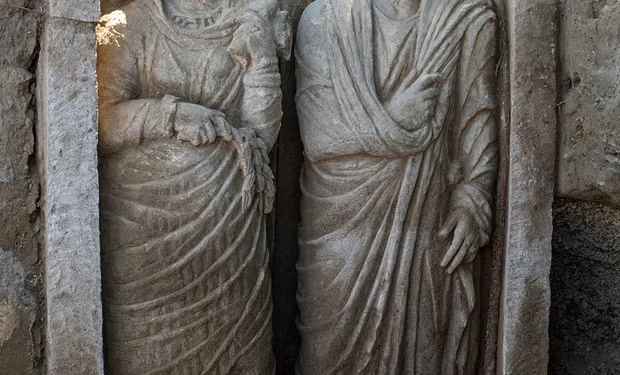In a remarkable discovery, archaeologists exciting the Porta Sarno Necropolis In Pompeii, he discovered two almost vine sculptures of a man and a woman, who would have been an eminent local figure, perhaps a priestess. The discovery, which has been reported by The guardianhighlights the roles of women in ancient Rome and offers a rare overview of Pompeii’s social structures before its destruction by Mount Vesuve In 79 AD. These exquisite statues, featuring complex details on clothing and jewelry, belongs to a high -ranking individual and provide new information on the city’s elite society.
A treasure hidden in the necropolis
The sculptures were found in a large tomb located in the Porta Sarno NecropolisOne of the main entry doors in the ancient Roman city. The tomb contains several funeral niches integrated into a large wall, and the experts think that it dates back to Period of the late Roman Republic. The female figure is dressed in a Large cape on a tunichis veiled face and decorated with jewelry – including earrings, rings and a Moon -shaped pendant. These jewelry, especially the lunulaUnderlines the high status of women, which could have been an influential member of the local elite.
Gabriel Zuchtriegelthe director of Pompeii archaeological parkcommented on the possibility that female sculpture represents a Ceres priestessThe goddess of agriculture, fertility and maternal relations. He explained: “Because she really looks like a very important woman in the local elite, there is also this idea that she could have been a priestess of Ceres, holding these plants and what seems to be a papyrus bread.”


A priestess in a patriarchal society
In ancient Rome, women were generally relegated to domestic roles, but being a priestess gave them a powerful position in society. A priestess had an authority similar to male priests and was involved in large rituals and public ceremonies. The female figure of sculpture is also represented by holding Laurel leaveswhich have been used to purify and bless the sacred spaces. This religious symbol also supports the theory that it occupied a high -ranking role within Roman society.
Although the two sculptures seem to be twinned, experts are not convinced that they represent a married couple. Zuchtriegel stressed: “Sometimes you get two men, or sometimes they come in three” and noted: “It could be her husband, but it could also be her son. There was no registration, so we don’t know. ” Without additional inscriptions, the real relationship between figures remains a mystery, but it is clear that the two occupied important positions in society.
A surprising element: the root of the tree
An unexpected characteristic of the tomb is the presence of a tree root which had developed on the feet of the male statue. The root was discovered just centimeters below the surface, and its inclusion during excavation was a surprise to the team. Zuichtriegel pointed out: “It was a surprise to find it there a few centimeters under the ground”, adding more to the mystery and the intrigue of the site. The growth of the tree at the top of the tomb suggests a natural interaction with the grave over time, preserving an ancient environmental connection.
Restore the past
The two sculptures are currently undergoing restoration, and they will be displayed in an exhibition at Pompei departure April 162025. Visitors will have the opportunity to admire the crafts of these sculptures and to explore their potential meaning in understanding the role of elite women in ancient Roman society. This discovery also highlights the continuous importance of archaeological efforts in Pompeii, who constantly discover treasures that deepen our understanding of the ancient world.
Excavations discovering the secrets of Pompeii
These sculptures are the last of a series of remarkable discoveries to Pompeia frozen city in time by the eruption of Mount Vesuve. The excavations of Porta Sarno Necropolis are a joint project between Pompeii Archaeological Park and the European University of Valence, and they continue to reveal aspects previously unknown to the social and religious life of Pompeii. For example, in 2021The researchers discovered the remains of an ancient slave who had set up the social scale, highlighting the complexity of Pompeii’s social hierarchies.
The discovery of these realistic sculptures Offers new perspectives on the religious and social structures of the Pompeii elite, in particular the roles that women could have played in public and religious life. While more of Pompeii’s past is revealed, it is clear that this ancient city still contains many secrets waiting to be discovered.


